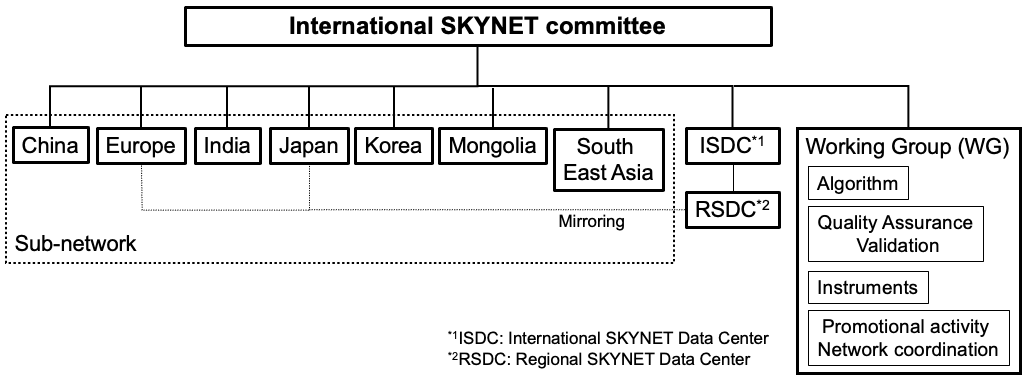

About SKYNET
The SKYNET is a ground-based radiation observation network dedicated to aerosol-cloud-solar radiation interaction researches (e.g., Takamura et al., 2004; Nakajima et al.,2007; Nakajima et al. 2020).
Objectives
The primary objectives of SKYNET are:
- to quantitatively evaluate long-term variations of aerosols and clouds properties, and therefore of the atmospheric radiation reaching the surface;
- to understand their effects on climate because of aerosol-cloud-solar interaction.
In addition, the validation for satellite observations of Japan Aerospace Exploration Agency (JAXA), European Space Agency (ESA) and National Aeronautics and Space Administration (NASA) mission as well as climate model simulations and data assimilations are also within the scope of the SKYNET activity.
To accomplish these objectives, SKYNET observes optical and microphysical properties of aerosols and clouds and measures atmospheric radiation founded on a close international collaboration among national agencies, institutes, and universities.
Organization
The SKYNET is organized in seven regional sub-networks, whose representatives are part of the International SKYNET committee that is the decision-making body of the network. The current committee members are listed in Table 1.
Each sub-network contributes for operating and maintaining the associated instrumentation. Some sub-networks have Regional SKYNET Data Center (RSDC) to accumulate data measured in the sub-network. Each SKYNET participant belongs to one of the seven sub-networks.
The raw data are transferred from each RSDC to the International SKYNET Data Center (ISDC). The ISDC produces standard products on aerosol optical properties using the standard algorithms approved by the International committee and provides products via web.
Each RSDC produces new research products, using also algorithms regionally developed. For example, The European SKYNET radiometers network (ESR) is one of the RSDC, leaded by Institute of Atmospheric Sciences and Climate (ISAC) of the Italian National Research Council (CNR) and by the University of Valencia. ESR has a regional data center located in Italy and in Spain and dedicated web page. While ESR mainly collects and analyzes data from the European subnetwork, Center for Environmental Remote Sensing (CEReS), Chiba University leads another RSDC located in Japan, which collects and analyzes data mainly from the Japanese, Mongolian, and Southeast Asian sub-networks, and provides research products through the web page.
Currently, there are four working groups (WGs);
- The algorithm WG for discussion of algorithms retrieving various atmospheric parameters such as aerosols, clouds, gases and radiation
- The Quality Assurance Validation WG for discussion of QA/QC and validation
- The Instrument WG for discussion of improvements to existing instrument and development of new instrument
- The Promotional activity Networking coordination WG for discussion of utilization and development of SKYNET data and observation network
Figure 1 shows the organization of SKYNET explained above.

| Chair |
M. Campanelli (ISAC-CNR) | |
| Vice co-chairs |
H. Irie (Chiba U.), H. Che (CMA) | |
| Honorary member |
T. Nakajima (NIES) | |
| Sub-network | China |
H. CHe (CMA), D. Liu (AIOFM) |
| Europe |
V. Estelles (U.Valencia), H. Diemoz (Arpa VDA), M. Campanelli |
|
| India |
V.K. Soni (IMD), G. Pandithurai (IITM) |
|
| Japan |
H. Irie, T. Nakajima |
|
| Korea |
S.W. Kim (SNU), J.H. Koo (Yonsei U.) |
|
| Mongolia |
N. Tugjsuren (MUST) |
|
| South East Asia |
T. Jarupongsakul (Chulalonkorn U.) |
|
| Working Group | Quality Assurance-Validation |
H. Che, V. Estelles, H. Diemoz, H. Irie, T. Nishizawa(NIES) |
| Algorithm |
H. Irie, A. Higurashi (NIES), P. Khatri (Tohoku U.), M. Hashimoto (JAXA), M. Campanelli, V. Estelles, H. Che, Y. Choi, T. Nakajima, R. Kudo (MRI), M. Momoi (GRASP SAS) |
|
| Instruments |
A. Uchiyama(NIES), B.Olivieri (ISAC), M.Campanelli, P. Khatri, D.Liu |
Promotional Activity Network Coodination |
S.W. Kim, M. Campanelli, G. Pandithurai, K. Aoki (Toyama U.) |
| ISDC |
T. Nishizawa, A. Higurashi |
- References
Takamura T. and Nakajima T., Overview of SKYNET and its activities, Opt. Pura Apl. 37, 3303-3308, 2004.
Nakajima T. et al., Overview of the Atmospheric Brown Cloud East Asian Regional Experiment 2005 and a study of the aerosol direct radiative forcing in east Asia, J. Geophys. Res., 112, D24S91, doi:10.1029/2007JD009009, 2007.
Nakajima T. et al., An overview of and issues with sky radiometer technology and SKYNET, AMT, 13, 4195-4218, 2020.